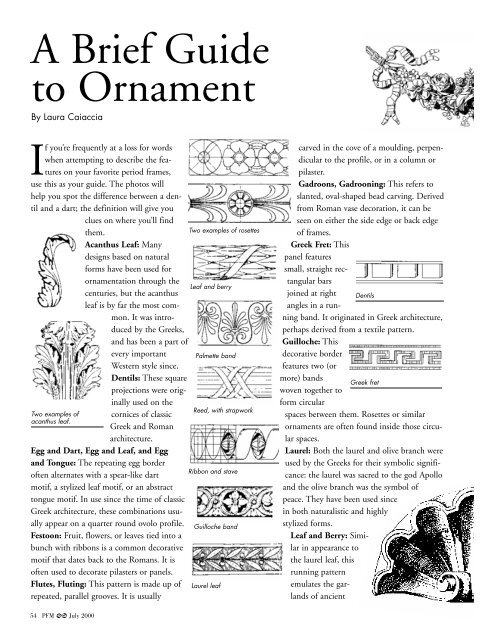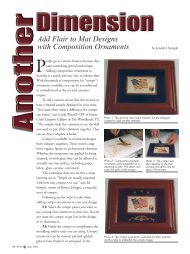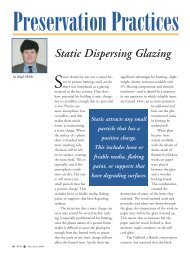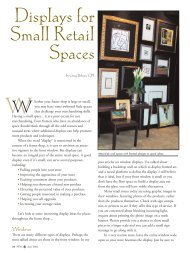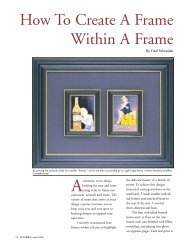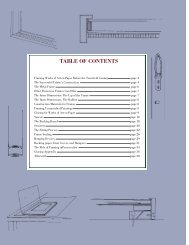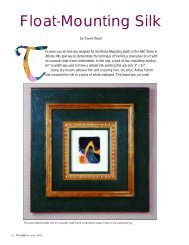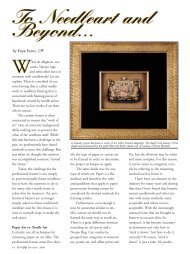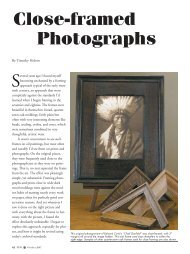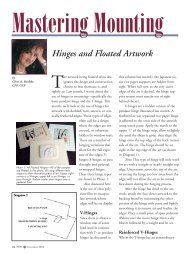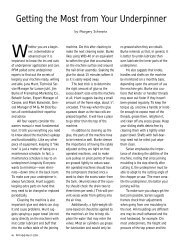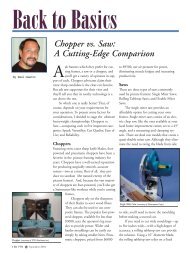A Brief Guide to Ornament - Picture Framing Magazine
A Brief Guide to Ornament - Picture Framing Magazine
A Brief Guide to Ornament - Picture Framing Magazine
Create successful ePaper yourself
Turn your PDF publications into a flip-book with our unique Google optimized e-Paper software.
A <strong>Brief</strong> <strong>Guide</strong><br />
<strong>to</strong> <strong>Ornament</strong><br />
By Laura Caiaccia<br />
If you’re frequently at a loss for words<br />
when attempting <strong>to</strong> describe the features<br />
on your favorite period frames,<br />
use this as your guide. The pho<strong>to</strong>s will<br />
help you spot the difference between a dentil<br />
and a dart; the definition will give you<br />
clues on where you’ll find<br />
them.<br />
Acanthus Leaf: Many<br />
designs based on natural<br />
forms have been used for<br />
ornamentation through the<br />
centuries, but the acanthus<br />
leaf is by far the most common.<br />
It was introduced<br />
by the Greeks,<br />
and has been a part of<br />
every important<br />
Western style since.<br />
Dentils: These square<br />
projections were originally<br />
used on the<br />
Two examples of<br />
acanthus leaf.<br />
54 PFM i July 2000<br />
cornices of classic<br />
Greek and Roman<br />
architecture.<br />
Egg and Dart, Egg and Leaf, and Egg<br />
and Tongue: The repeating egg border<br />
often alternates with a spear-like dart<br />
motif, a stylized leaf motif, or an abstract<br />
<strong>to</strong>ngue motif. In use since the time of classic<br />
Greek architecture, these combinations usually<br />
appear on a quarter round ovolo profile.<br />
Fes<strong>to</strong>on: Fruit, flowers, or leaves tied in<strong>to</strong> a<br />
bunch with ribbons is a common decorative<br />
motif that dates back <strong>to</strong> the Romans. It is<br />
often used <strong>to</strong> decorate pilasters or panels.<br />
Flutes, Fluting: This pattern is made up of<br />
repeated, parallel grooves. It is usually<br />
Two examples of rosettes<br />
Leaf and berry<br />
Palmette band<br />
Reed, with strapwork<br />
Ribbon and stave<br />
Guilloche band<br />
Laurel leaf<br />
carved in the cove of a moulding, perpendicular<br />
<strong>to</strong> the profile, or in a column or<br />
pilaster.<br />
Gadroons, Gadrooning: This refers <strong>to</strong><br />
slanted, oval-shaped bead carving. Derived<br />
from Roman vase decoration, it can be<br />
seen on either the side edge or back edge<br />
of frames.<br />
Greek Fret: This<br />
panel features<br />
small, straight rectangular<br />
bars<br />
joined at right Dentils<br />
angles in a running<br />
band. It originated in Greek architecture,<br />
perhaps derived from a textile pattern.<br />
Guilloche: This<br />
decorative border<br />
features two (or<br />
more) bands<br />
Greek fret<br />
woven <strong>to</strong>gether <strong>to</strong><br />
form circular<br />
spaces between them. Rosettes or similar<br />
ornaments are often found inside those circular<br />
spaces.<br />
Laurel: Both the laurel and olive branch were<br />
used by the Greeks for their symbolic significance:<br />
the laurel was sacred <strong>to</strong> the god Apollo<br />
and the olive branch was the symbol of<br />
peace. They have been used since<br />
in both naturalistic and highly<br />
stylized forms.<br />
Leaf and Berry: Similar<br />
in appearance <strong>to</strong><br />
the laurel leaf, this<br />
running pattern<br />
emulates the garlands<br />
of ancient
Rome.<br />
Palmette: Like many ornaments,<br />
the palmette originated in Greece.<br />
It contains an odd number of nar-<br />
row leaves in a symmetrical arrangement. It can be used alone or in bands.<br />
Pearls: Small balls rendered in slightly more than half relief are often know<br />
as pearls. These are usually accompanied by discs and ovals; the disc<br />
is sometimes called a “reel,” and the oval is commonly known by<br />
names such as “sausage” or “bar.” Pearls, in<br />
combination or alone, are used most often<br />
<strong>to</strong> ornament small, half round mouldings,<br />
or below other ornaments, such as egg and<br />
dart, on a larger profile.<br />
Reed: The reed ornament is found on <strong>to</strong>rus<br />
mouldings, sometimes designed <strong>to</strong> look as if<br />
the reeds are bound <strong>to</strong>gether by scrolling<br />
leaves, straps, or ribbons.<br />
Ribbon and Stave, Ribbon and Stick: This ornament is<br />
Two examples of scrolling<br />
foliage<br />
usually carved on a bead moulding and resembles a spiraling ribbon<br />
wound around a rod.<br />
Rosette: Rosettes seem as<br />
more or less naturalistic flowers from a front view,<br />
commonly used singly or repeated in bands. These<br />
can either be directional or perfectly symmetrical.<br />
Scrolling Foliage: Creative interpretations of natural<br />
foliage have lead <strong>to</strong> many forms of ornament. Yet<br />
few natural plants have tendrils, and there are many<br />
forms of execution within the various styles where<br />
this motif appears. Also called Leaf Spiral.<br />
Shells: Both the nautilus shell and<br />
the scallop shell have been<br />
used as decorative ornamentation<br />
since the Renaissance.<br />
Here a highly<br />
stylized scallop shell is<br />
shown. ■<br />
Shell<br />
Fes<strong>to</strong>on<br />
Line art from Dover’s Handbook<br />
of <strong>Ornament</strong>.<br />
Gardrooning occurs at the sight<br />
edge.<br />
Fluted coves enhance these<br />
frames.<br />
Egg and <strong>to</strong>ngue Egg and leaf<br />
Egg and dart Egg and <strong>to</strong>ngue<br />
Various examples of pearl ornaments<br />
The <strong>to</strong>p rail of this<br />
frame (shown vertically)<br />
features a<br />
guilloche band<br />
and scrolling<br />
acanthus leafs surmounted<br />
by a<br />
shell.


